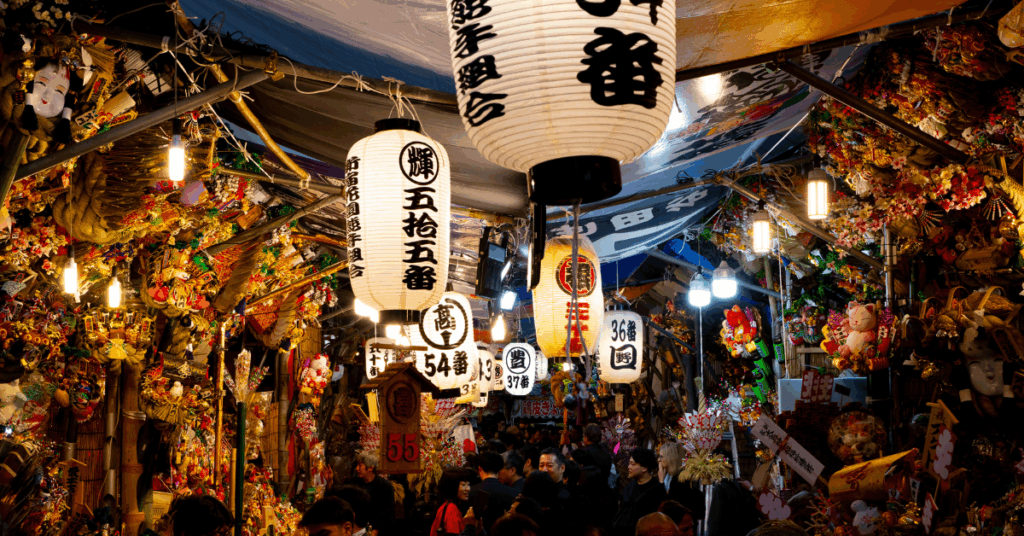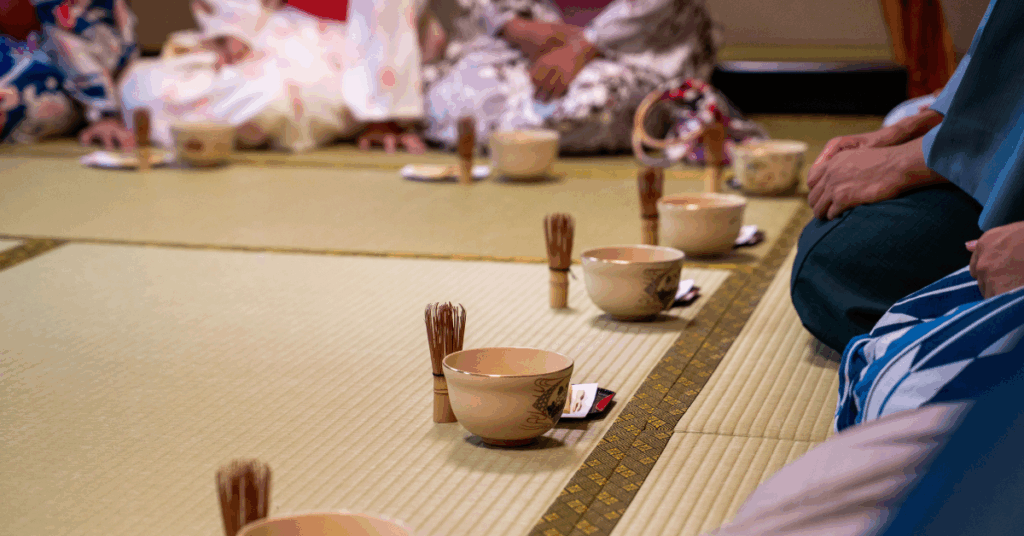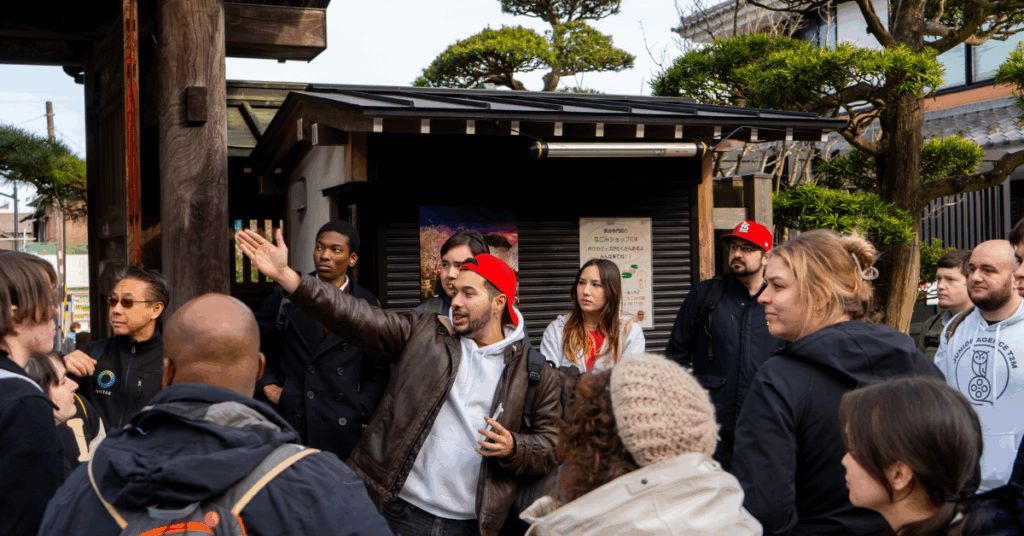Which season is best for me?
The best season to visit Japan depends on the experience you are looking for, with spring offering the iconic sakura season, summer bringing vibrant festivals, autumn showcasing stunning colors, and winter providing a magical, festive atmosphere. This guide will walk you through the pros and cons of each season to help you decide.
Main key takeaways
- Spring is beautiful and bustling, famous for sakura but also peak crowds.
- Summer is hot and energetic, perfect for experiencing local festivals and fireworks.
- Autumn offers comfortable weather, stunning fall colors, and delicious seasonal food.
- Winter is the least crowded season, offering a magical experience with city illuminations and a cozy atmosphere.
- Our seasonal Study Trips are designed to help you experience the best of each unique time of year.
When is the best season to visit Japan? A quick comparison
This simple table gives a high-level overview of what to expect from the climate and atmosphere in each season.
| Spring (March to May) | Summer (June to August) | Autumn (September to November | Winter (December to February) | |
| Vibe | Beautiful & Bustling | Energetic & Festive | Colorful & Comfortable | Magical & Festive |
| Weather | Mild and pleasant | Hot and humid | Cool and crisp | Cold and clear |
| Crowds | High (peak season) | High (vacation season) | Moderate (shoulder season) | Low (off-peak) |
Which season do students choose most?
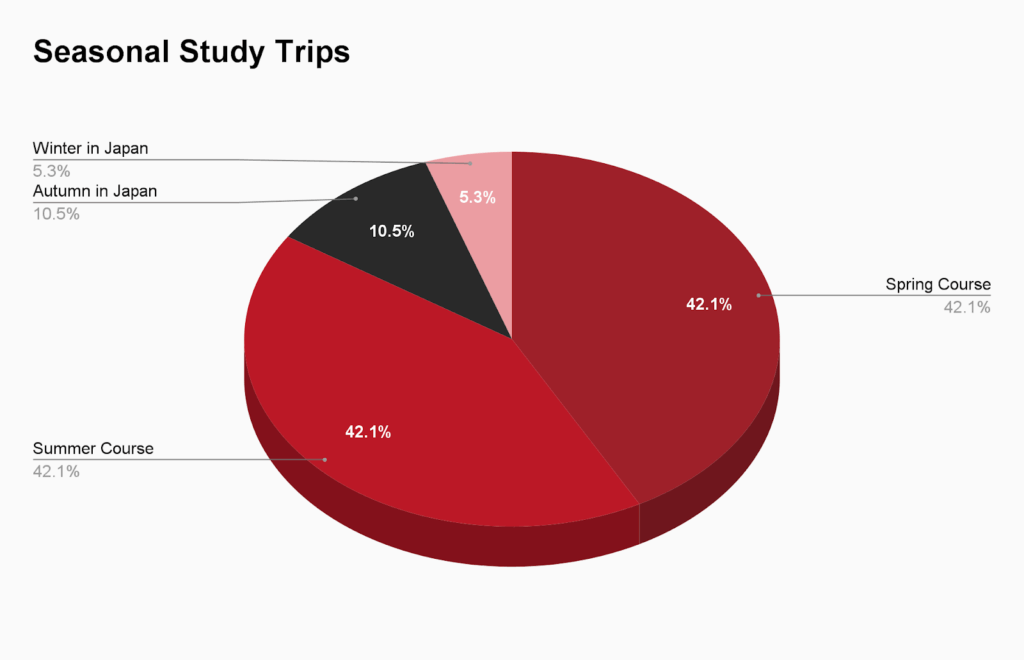
Our 2024 student survey shows that while every season offers a unique experience, the Summer and Spring Courses are the most popular choices. We looked at our 2024 survey data, and as you can see:
- Summer Course is incredibly popular, perfect for students on their school break who want to experience Japan’s vibrant festival season.
- Spring Course is just as popular for those who have always dreamed of experiencing sakura season. And for those looking for beautiful scenery with more comfortable weather and fewer crowds.
- Autumn in Japan is a fantastic choice, offering a beautiful season for Study Trips with stunning natural landscapes and vibrant cultural experiences.
- Winter in Japan is a unique option for those seeking a less crowded experience.
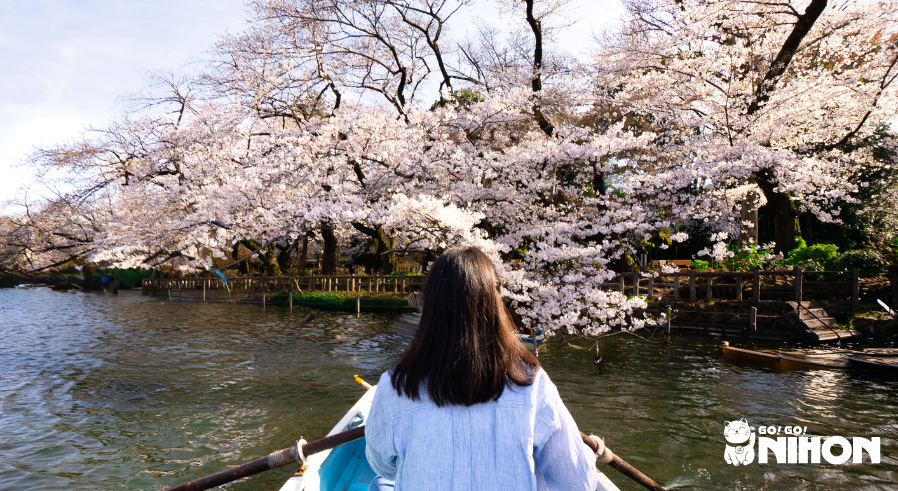
What can I expect during spring in Japan?
Spring (March to May) is a spectacular season in Japan, celebrated for its pleasant weather and iconic cherry blossoms. This makes it an incredibly popular time to visit, creating a vibrant and energetic atmosphere as people from all over come to experience the beauty.
This is a beautiful time of year, with mild temperatures perfect for exploring. The main event is, of course, the cherry blossoms. As our Student Advisor, Crystal, notes, “many Study Trippers say it has always been their dream to experience cherry blossoms, and they are so happy they could come to Japan during sakura season.”
One of our previous students, Peter Garden, shared,
“I attended the Spring Course provided by Go! Go! Nihon, and it was excellent. The staff at Studytrip.com were superb, the teachers at the language school were patient, kind, and friendly. The trips and activities organized as part of the Study Trip were interesting and varied. Overall, it was a great experience and I would highly recommend it to anyone looking for short term study and a taste of Japan.”
A highlight of our Spring Course Study Trip is a traditional spring picnic, which is the perfect way to experience this beautiful season. We try to time our Study Trips to give you the best possible chance of seeing the iconic cherry blossoms in full bloom, but it is important to remember that the sakura season is fully weather-dependent and its timing can change each year. This is also peak tourist season, so you can expect larger crowds, especially during Golden Week in early May.
For further reading, read our blog article “What to do in Japan in Spring: the best seasonal activities”.
Is summer a good time to visit Japan?
Summer (June to August) in Japan is very hot and humid but is also the season of incredible festivals, fireworks, and a vibrant, social atmosphere.
While the weather can be intense, summer is a popular time for student travel due to school holidays. It is the best time to experience uniquely Japanese summer activities, from joining locals in traditional Bon Odori dances in a yukata to making your own fireworks under the guidance of Japan’s largest firework producer.
“Bon Odori are traditional Japanese folk dances performed during the Obon festival to honor ancestral spirits. Participants often wear yukata and dance to the beat of drums, creating a lively and shared atmosphere.”
Our team has seen firsthand how the summer atmosphere creates lasting memories and friendships. As our Tour Leader, Jose, explains:
“Students mention how the people are more open, and they tend to go out and explore more together. The summer course tends to be the one course where the students bond the most and are super close, so it’s a very unique aspect and we always say it’s thanks to the vibrant, festive summer atmosphere. Normally, the beach trip with the ’Suica Wari’ and smaller fireworks becomes a big memory for the students.”
A classic Japanese summer experience is a trip to the beach, which often includes suikawari, a fun game where blindfolded players take turns trying to break open a watermelon with a stick, similar to a piñata. Jose notes that “the beach trip with the ‘Suikawari’ and smaller fireworks becomes a big memory for the students.”
Zachary, a former student, described our Summer Course in Japan as amazing. He said,
“I thought it was amazing. From the people I got to meet, both teachers and fellow students, to the things I got to see and learn, overall I think it has been a great experience for my first time in Japan.”
Read his Summer Course Japan journey.
A highlight of our Summer Course in Japan is experiencing a vibrant local festival, complete with traditional dancing and a spectacular fireworks show, which is the perfect way to enjoy the energetic atmosphere of the season. It is important to note, however, that summer in Japan is typically hot and humid, so we recommend packing light, breathable clothing.
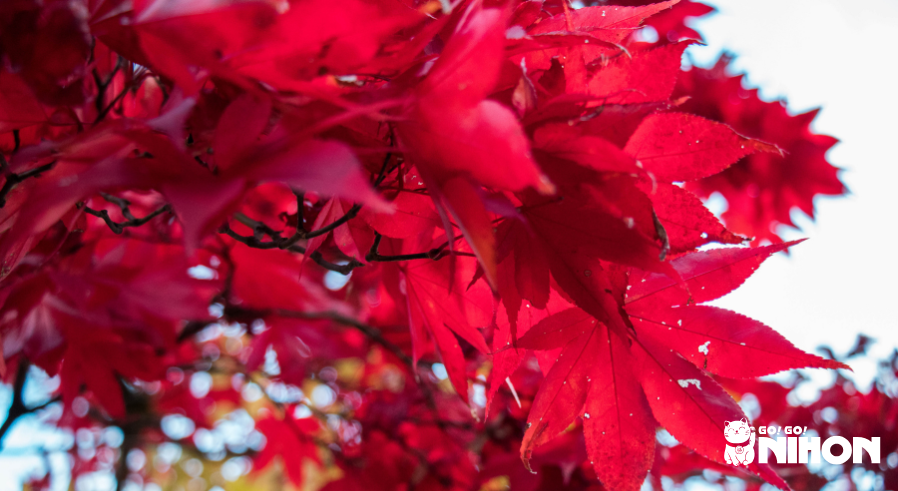
Why is autumn considered a great time to visit Japan?
Autumn (September to November) is considered by many to be the best time to visit Japan, offering a spectacular display of fall colors, comfortable weather, and fewer crowds than spring.
When autumn arrives in Japan, the landscapes transform with stunning shades of red, orange, and yellow. This seasonal tradition of viewing the colorful leaves is known in Japanese as momiji, which is also the word for the Japanese maple tree. Every year, people travel all over the country to see the beautiful autumn leaves, and you can find the perfect spot in our complete guide to the best locations to experience autumn in Japan.
The weather during this season is cool, crisp, and pleasant, which is ideal for exploring. This is a fantastic ”shoulder season” with a more relaxed atmosphere. A highlight of the Autumn in Japan Study Trip is a day trip to see the stunning autumn leaves in a historic town. For a different kind of fall experience, our Akita Autumn Study Trip takes you to the countryside for a deep cultural immersion.
Our tour leader, Jose, has some practical advice for a fall trip to a mountain town like Nikko:
“Always wear comfortable clothes suitable for walking, almost hiking, due to how much of a trek it is, and it is also surprisingly cold considering it is a mountain town”.
What makes winter in Japan a magical experience?
Winter (December to February) in Japan is cold but offers a magical experience with beautiful city illuminations, festive markets, and the fewest crowds of the year.
The weather is generally cold and clear, offering a different kind of beauty. This is the best off-peak season for students who want a more relaxed and budget-friendly trip.
While it may be colder, winter in Japan is full of unique and cozy activities. It is a fantastic time to enjoy heart-warming food like a traditional nabe (hot pot) dinner, visit a relaxing onsen (hot spring), or see the cities sparkle with incredible winter illuminations. For a deeper look into the season, you can read our guide on the many magical things to do in Japan in winter. A key highlight of the Winter in Japan Study Trip is experiencing this festive atmosphere firsthand, while our Akita Winter Study Trip offers a chance to see the serene beauty of the Japanese countryside covered in snow.
FAQ about the Go! Go! Nihon Study Trip team
- What is the weather like in Japan year-round?
Japan experiences four distinct seasons, from the mild and pleasant spring to the hot and humid summer, the cool and crisp autumn, and the cold and clear winter. - When is the busiest time to visit Japan?
The busiest times to visit Japan are typically during the spring cherry blossom season (late March to April) and during the Golden Week holiday in late April/early May. - What is the best season to visit Japan to avoid crowds?
Winter (December to February) is generally the least crowded season, offering a more relaxed travel experience. - Which season is right for me?
The best season depends on your priorities. If you dream of seeing cherry blossoms, choose spring. If you love lively festivals, choose summer. For comfortable weather and beautiful colors, choose autumn. For a magical atmosphere with fewer crowds, choose winter.
Conclusion:
Now that you know what each season has to offer, you can choose the one that best fits your dream study trip. Ready to experience your perfect season in Japan? Explore our seasonal study trips today!
